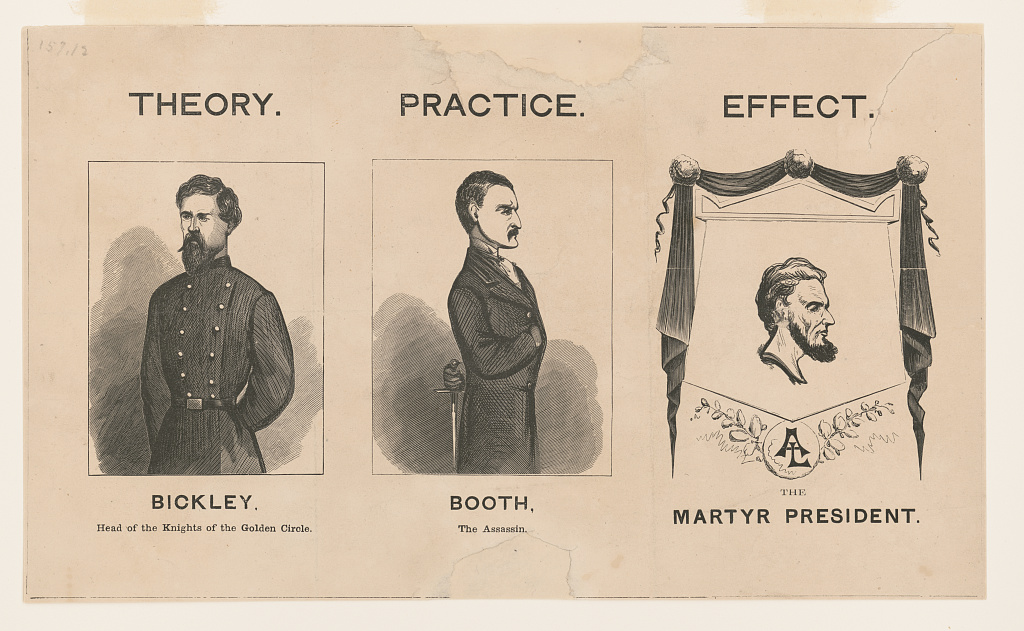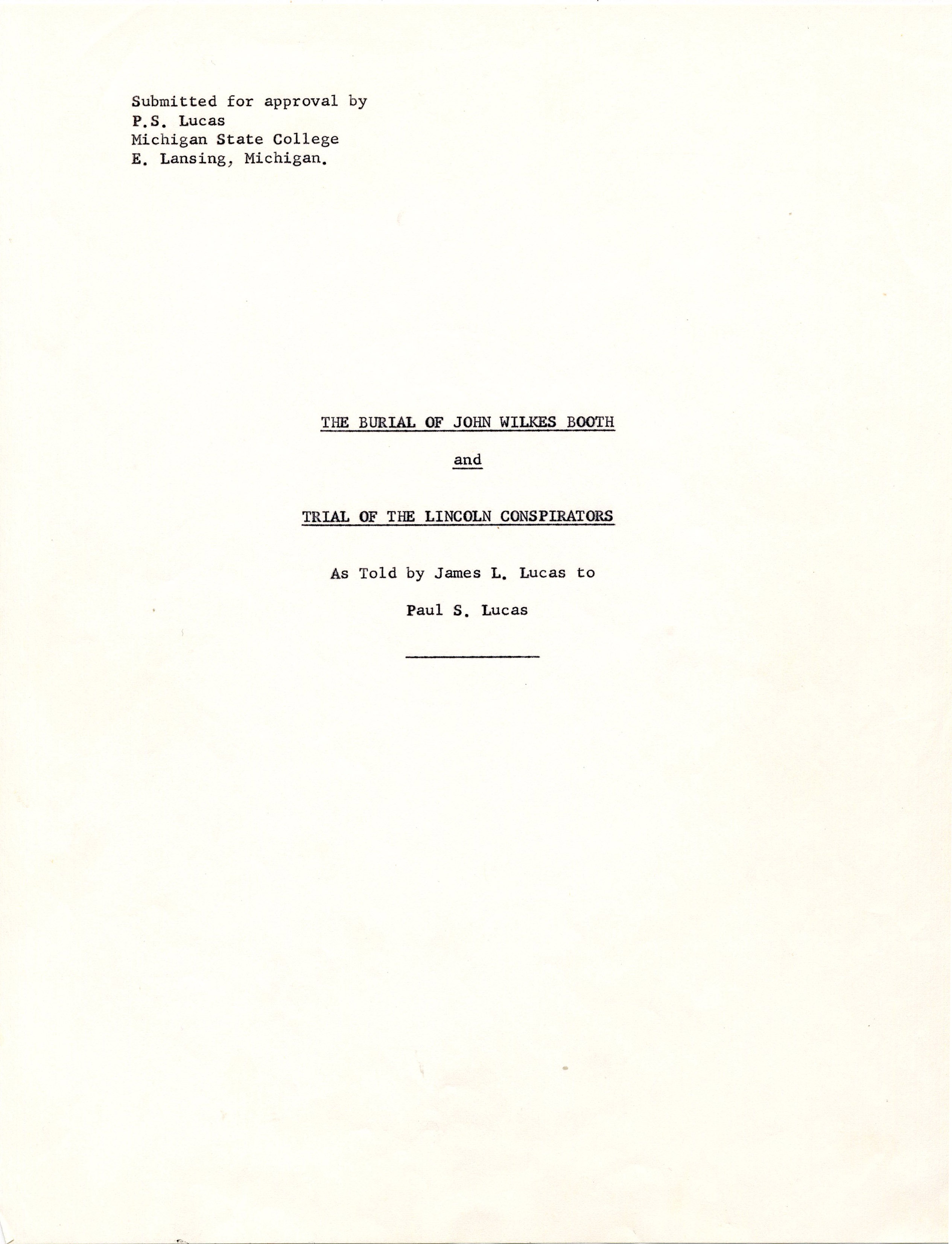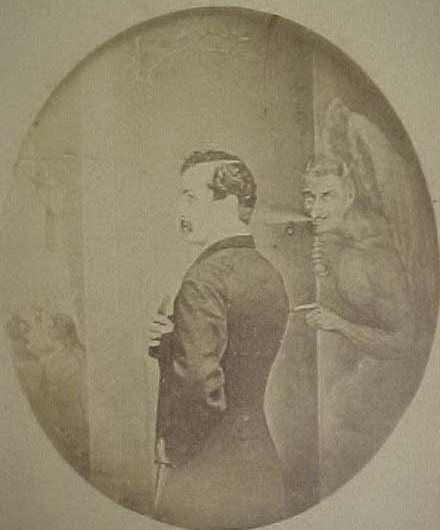from May. 1, 1865
Theory. Practice. Effect.
-
Full Title
Theory. Practice. Effect.
-
Description
This print attributes John Wilkes Booth's assassination of Abraham Lincoln to the influence of the Knights of the Golden Circle, the proslavery secret society. The first panel labels "Theory" as George W. L. Bickley, the "Head of the Knights of the Golden Circle," standing in for the society's ideology. Under "practice" is John Wilkes Booth with a dagger behind his back with the "Effect" being the death of President Lincoln.
-
Source
Library of Congress, Prints and Photographs Division, LC-DIG-pga-13665
-
Rights
This item is in the public domain and may be reproduced and used for any purpose, including research, teaching, private study, publication, broadcast or commercial use, with proper citation and attribution.
-
Tags
-
Cite this Item
unknown. "Theory. Practice. Effect.". Remembering Lincoln. Web. Accessed June 27, 2025. https://rememberinglincoln.fords.org/node/1156
-
Creator
unknown
-
Date
1865
-
Material
wove paper and wood engraving
-
Dimensions
14 x 29.2 cm
from May. 1, 1865
Theory. Practice. Effect.

-
Description
This print attributes John Wilkes Booth's assassination of Abraham Lincoln to the influence of the Knights of the Golden Circle, the proslavery secret society. The first panel labels "Theory" as George W. L. Bickley, the "Head of the Knights of the Golden Circle," standing in for the society's ideology. Under "practice" is John Wilkes Booth with a dagger behind his back with the "Effect" being the death of President Lincoln.
-
Source
Library of Congress, Prints and Photographs Division, LC-DIG-pga-13665
-
Rights
This item is in the public domain and may be reproduced and used for any purpose, including research, teaching, private study, publication, broadcast or commercial use, with proper citation and attribution.
-
Creator
unknown
-
Date
May 1, 1865
-
Material
wove paper and wood engraving
-
Dimensions
14 x 29.2 cm
from Jan. 1, 1889
Scrapbook of Charles B. Andrus
-
Full Title
Scrapbook of Charles B. Andrus
-
Description
Excerpt of news-clippings from the scrapbook of Charles B. Andrus (1848-1937); member and commander of quasi-military organization Putnam phalanx in Hartford, CT. Contains descriptions of Abraham Lincoln's assassination along with juxtaposition of Lincoln and James Garfield's assassins. News-clippings attempt to draw conclusions about the motivations of the assassins based-upon a comparison of physical and emotional traits of each assassin.
-
Source
Ms 86281
-
Rights
Use of this item for research, teaching and private study is permitted with proper citation and attribution to the Connecticut Historical Society. Reproduction of this item for publication, broadcast or commercial use requires permission. For permission, please contact the Connecticut Historical Society. chs.org/research/digital-reproductions.
-
Tags
-
Cite this Item
Charles Andrus. "Scrapbook of Charles B. Andrus ". Daniel Slote & Co, New York (scrapbook). Remembering Lincoln. Web. Accessed June 27, 2025. https://rememberinglincoln.fords.org/node/865
from Jan. 1, 1889
Scrapbook of Charles B. Andrus

-
Description
Excerpt of news-clippings from the scrapbook of Charles B. Andrus (1848-1937); member and commander of quasi-military organization Putnam phalanx in Hartford, CT. Contains descriptions of Abraham Lincoln's assassination along with juxtaposition of Lincoln and James Garfield's assassins. News-clippings attempt to draw conclusions about the motivations of the assassins based-upon a comparison of physical and emotional traits of each assassin.
-
Source
Ms 86281
-
Rights
Use of this item for research, teaching and private study is permitted with proper citation and attribution to the Connecticut Historical Society. Reproduction of this item for publication, broadcast or commercial use requires permission. For permission, please contact the Connecticut Historical Society. chs.org/research/digital-reproductions.
-
Creator
Charles Andrus
-
Publisher
Daniel Slote & Co, New York (scrapbook)
-
Date
January 1, 1889
-
Material
bound book containing newsprint clippings
-
Dimensions
28.5cm x 21cm
from Sep. 1, 2015
James L. Lucas Recollection
-
Full Title
The Burial of John Wilkes Booth and Trial of the Lincoln Conspirators
-
Description
This manuscript was typed by Paul S. Lucas from James Lucas' narration. In the manuscript, James Lucas describes the American political scene in the 1850's and the coming of the Civil War. He gives an eyewitness account of Washington in the war years, including a description of Lincoln in great detail. Lucas spent three years with the 12th Veteran Reserve Corps, who served as guards for the Old Capitol Prison, where the Lincoln conspirators were held. Lucas also served as a court messenger during the prisoners' trial, and he describes the conspirators as well as the trial itself. In addition, Lucas tells of guarding the body of John Wilkes Booth on the monitor "Montauk" and of the secret burial of the assassin's body in the Old Capitol prison.
-
Source
c.00086 - James L. Lucas Manuscript
-
Rights
Educational use only, no other permissions given. Copyright to this resource is held by Michigan State University and is provided here for educational purposes only. It may not be reproduced or distributed in any format without written permission of the University Archives & Historical Collections, Michigan State University.
-
Tags
-
Cite this Item
As Told by James L. Lucas to Paul S. Lucas. "The Burial of John Wilkes Booth and Trial of the Lincoln Conspirators". Michigan State University Archives & Historical Collections. Remembering Lincoln. Web. Accessed June 27, 2025. https://rememberinglincoln.fords.org/node/855
-
Creator
As Told by James L. Lucas to Paul S. Lucas
-
Publisher
Michigan State University Archives & Historical Collections
-
Date
date unknown
-
Material
Typed on Paper
-
Dimensions
8" x 11"
from Sep. 1, 2015
The Burial of John Wilkes Booth and Trial of the Lincoln Conspirators

-
Description
This manuscript was typed by Paul S. Lucas from James Lucas' narration. In the manuscript, James Lucas describes the American political scene in the 1850's and the coming of the Civil War. He gives an eyewitness account of Washington in the war years, including a description of Lincoln in great detail. Lucas spent three years with the 12th Veteran Reserve Corps, who served as guards for the Old Capitol Prison, where the Lincoln conspirators were held. Lucas also served as a court messenger during the prisoners' trial, and he describes the conspirators as well as the trial itself. In addition, Lucas tells of guarding the body of John Wilkes Booth on the monitor "Montauk" and of the secret burial of the assassin's body in the Old Capitol prison.
-
Source
c.00086 - James L. Lucas Manuscript
-
Rights
Educational use only, no other permissions given. Copyright to this resource is held by Michigan State University and is provided here for educational purposes only. It may not be reproduced or distributed in any format without written permission of the University Archives & Historical Collections, Michigan State University.
-
Creator
As Told by James L. Lucas to Paul S. Lucas
-
Publisher
Michigan State University Archives & Historical Collections
-
Date
September 1, 2015
-
Material
Typed on Paper
-
Dimensions
8" x 11"
from May. 1, 1865
Assassination Event
-
Full Title
Assassination Event
-
Description
Carte-de-visite showing an armed Booth standing outside the Presidential Box at Ford's Theater. The devil is standing behind and to Booth's side, whispering into his ear. The box's occupants are visible beyond Booth's other side. Below the overlapped image is the legend, "John Wilkes Booth. The Assassin."
-
Source
-
Rights
Use of this item for research, teaching and private study is permitted with proper citation and attribution, as defined here. Reproduction of this item for publication, broadcast or commercial use requires written permission. For permission, please contact the Abraham Lincoln Library and Museum of Lincoln Memorial University, Harrogate, TN.
-
Tags
-
Cite this Item
anonymous. "Assassination Event ". Remembering Lincoln. Web. Accessed June 27, 2025. https://rememberinglincoln.fords.org/node/238
from May. 1, 1865
Assassination Event

-
Description
Carte-de-visite showing an armed Booth standing outside the Presidential Box at Ford's Theater. The devil is standing behind and to Booth's side, whispering into his ear. The box's occupants are visible beyond Booth's other side. Below the overlapped image is the legend, "John Wilkes Booth. The Assassin."
-
Source
-
Rights
Use of this item for research, teaching and private study is permitted with proper citation and attribution, as defined here. Reproduction of this item for publication, broadcast or commercial use requires written permission. For permission, please contact the Abraham Lincoln Library and Museum of Lincoln Memorial University, Harrogate, TN.
-
Creator
anonymous
-
Date
May 1, 1865
-
Dimensions
4 inches high by 2 1/2 inches wide

